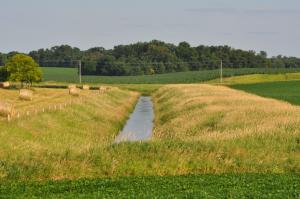Overview
Minnesota drainage law began with passage by the 1st Legislature of the State of Minnesota of “An Act to Regulate and Encourage the Drainage of Lands”, codified in Minnesota Statutes 1858, Chapter 128. Lands. Since that time, drainage law has evolved through numerous revisions and recodification, in response to experience with its use, case law, and the development of other state and federal laws. See “Minnesota Drainage Law, A Chronological Summary of Key Statute Titles, Numbers and Associated Headings (pdf)” for some pertinent history of drainage law development in Minnesota. Minnesota drainage law is currently found in Minnesota Statutes, Chapter 103E. Drainage.
Following are some key characteristics of Minnesota drainage law:
- The law enables multiple landowners to collectively construct, improve and repair drainage systems across property boundaries and governmental boundaries.
- These drainage systems can be open ditches and/or subsurface tile.
- Chapter 103E drainage systems are administered in accordance with Minnesota drainage law by a public drainage authority, which can be a County Board of Commissioners, a Joint County Board of Commissioners, or a Watershed District Board of Managers.
- The statute is substantially prescriptive and does not include associated rules. State courts have determined that drainage authorities must follow drainage law carefully.
- Drainage proceedings under the law are predominantly petition-based.
- Drainage law includes due process through petition requirements, public hearings, associated notification of interested property owners and the general public, and appeal processes.
The Minnesota Public Drainage Manual (MPDM), which was first published in 1991 and updated in 2016, provides detailed information and guidance about Minnesota Statutes, Chapter 103E Drainage law and associated topics. The MPDM is an important reference for drainage authorities, attorneys, engineers, viewers, drainage inspectors, and others involved with Chapter 103E drainage systems. It is important to recognize that the MPDM provides guidance, but is not rule or law.
See the following pages for more information on the inception and practical usage of the manual, on a user-friendly guide to drainage law, and on other drainage-related resources:

